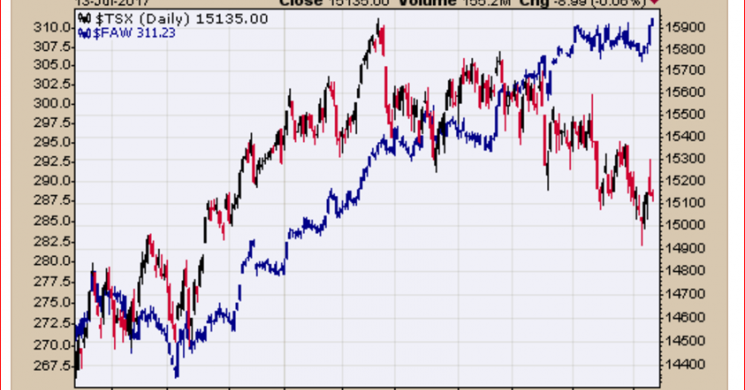
Where Is The Economy Going? Look At Canada
Written by Dennis Slothower for outsiderclub.com
Yellen Flips on Inflation & Economy
Janet Yellen concluded her latest testimony before the Senate giving mostly the same speech as she did in her previous testimony before Congress, but with some slight differences.
Yellen spun that she expected the economy to strengthen in 2018 and that inflation was expected to go higher next year, but in her testimony before the Senate she acknowledged that there may be other factors at work undercutting inflation and keeping the GDP growth below 3%.
Over the last five years U.S. productivity averaged only ½%, vs. 1% over the last 10 years, which has undercut the GDP with it averaging about 2%. She saw it as a real challenge to get the GDP averaging 3% for a given year, even under President Trump’s fiscal policy vision.
What Yellen avoided explaining is it is hard to improve U.S. productivity when wages are so low and so many people have to work two part-time jobs to make it. This is really the issue, which she never addressed. Obamacare as it exists now has undercut small business, where 70% of jobs are created.
Yellen expects the second quarter to see an improvement in the GDP from the 1.4% in the first quarter. Presently, the Bank of New York is forecasting a second quarter GDP at 1.9% and the Atlanta Fed at 2.6%, but it has been consistently lowering it. I think given how much the U.S. dollar has fallen this year, we should see some improvement.
Energy – The Weak Wild Card
Yet the wild card undercutting growth is the persistent weakness in the energy sector.
Crude oil prices remain in a bear market, along with other commodities. In this chart, we see a pattern of lower highs and lower lows, with oil prices trending below the 50- and 200-day moving averages. Oil stocks also remain in a bearish market.
It is naïve to think we should see the economy expanding when commodity prices are deteriorating. What’s more, crude oil prices are pegged to the U.S. dollar. Therefore, a falling dollar should lift energy prices whereas a rising dollar would pressure oil prices.
This is significant because crude oil prices should be going higher but in a strong, bearish divergence, oil continues to fall even with a bearish U.S. dollar. Were the dollar to strengthen just a small bit, crude oil prices would be crashing.
The central bankers are doing everything they can to hold crude oil prices up by depressing the U.S. dollar. One market that is a leading indicator of the U.S. market is the Canadian Toronto Stock Exchange ($TSX).
Historically, the $TSX leads the U.S. market up and down because Canada’s economy is highly dependent on commodities, i.e., oil.
The Canadian stock market has been falling this year and is now trending below both its 50-day and 200-day moving averages, with the 50-day moving average poised to make a cross down through its 200-day moving average here in July. This matters because it suggests the future U.S. GDP is about to run into trouble.
In this chart, we compare the Canadian stock market index in a ratio with the FSTE All World Index. The Canadian stock market is plunging, which suggests that not only is the Canadian economy in trouble but it won’t be long before the U.S. economy follows this same path.
This is why it doesn’t matter so much what Janet Yellen says. It is what the Fed does that matters and three rate hikes this year, perhaps a fourth rate hike in September or December, and cutting back on the Fed’s balance sheet in September will make an economic difference going forward.
Not that this should do much for the domestic stock market. There has been zero growth over the last three years in the S&P 500 companies’ earnings. In fact, the S&P 500’s corporate earnings growth is still not as good as it was in 2014.
Should the S&P 500 corporate earnings slow from the first quarter in its second quarter earnings, the gap widening further between price and EPS becomes ridiculous. History says this is a bridge too far.
Equity valuations are perched at levels that imply spectacular economic and earnings growth! That just isn’t happening, particularly with weak oil prices. Equity buyers are overpaying for a stream of future earnings that is sure to disappoint soon.
Seasonality is right before us as well. Historically, from mid-July through October, the volatility index (VIX), which is now at a near-historic low of 10.18, begins to soar.
This is why chasing the stock market at ridiculous P/E ratios, especially in the big technology stocks, is so dangerous now. We are seeing a massive topping for this economic cycle and from mid-July through October it looks set to correct, perhaps far more than anyone is expecting.
Dennis Slothower Editor, Wall Street Underground Profits
Read more by Soren K.Group












